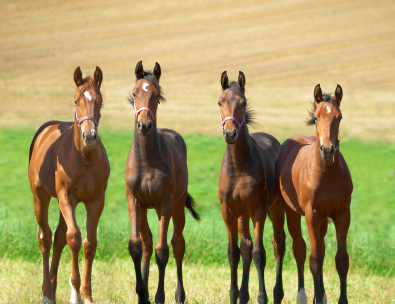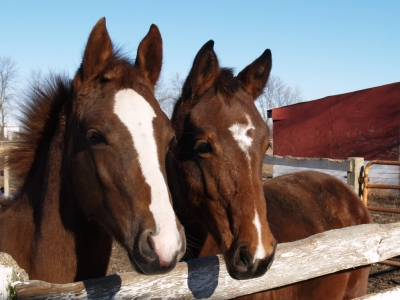 How you feed your foal once weaned depends a lot on breed and your future goals. Is your weanling destined for the sales or show ring, expected to race as a 2 year old, or will he be maturing slowly at home until going under saddle as a 4 year old? Is he a breed typically considered to be an easy keeper and at risk of getting fat or a higher calorie burning thoroughbred? No matter the breed or ultimate goal, two things are sure; growth needs to be steady and the diet needs to be made up of balanced, high quality, easily assimilated nutrients.
How you feed your foal once weaned depends a lot on breed and your future goals. Is your weanling destined for the sales or show ring, expected to race as a 2 year old, or will he be maturing slowly at home until going under saddle as a 4 year old? Is he a breed typically considered to be an easy keeper and at risk of getting fat or a higher calorie burning thoroughbred? No matter the breed or ultimate goal, two things are sure; growth needs to be steady and the diet needs to be made up of balanced, high quality, easily assimilated nutrients.
Horses less than a year old have a requirement for crude protein that is greater than they will have when mature. Shown in the graph below, the mature 500kg horse at maintenance is shown by the red bar and the foal’s total crude protein requirement is the sum of the green and blue bar each month.
Many breeders and owners of weanlings are still leery of feeding feeds high in protein for fear that this increases developmental orthopedic disease (DOD) risk. While this was thought to be true for a number of years the research has since been disproved and in fact it is diets too high in calories, especially from starch, or diets with poor mineral balance that are of greater risk.
 For this reason many weanling feeds now contain higher quantities of fat and fermentable fiber than was traditionally the case. Steady growth without major fluctuations reduces the risk of DOD’s such as physitis. While high fat feeds insure adequate calories for growth without relying on starch as an energy source, they should be fed carefully to insure the weanling does not become fat. The appearance of a fat weanling is often thought to be attractive in the show or sales arena however they may not be growing optimally or have the best bone development. Foals being prepared for these situations should be fed according to condition and be provided with ample opportunity to exercise in order to development muscle as opposed to fat.
For this reason many weanling feeds now contain higher quantities of fat and fermentable fiber than was traditionally the case. Steady growth without major fluctuations reduces the risk of DOD’s such as physitis. While high fat feeds insure adequate calories for growth without relying on starch as an energy source, they should be fed carefully to insure the weanling does not become fat. The appearance of a fat weanling is often thought to be attractive in the show or sales arena however they may not be growing optimally or have the best bone development. Foals being prepared for these situations should be fed according to condition and be provided with ample opportunity to exercise in order to development muscle as opposed to fat.
Condition should be monitored closely and a body condition score between 4 and 6 on the Hennecke body condition scoring (BCS) scale should be maintained. Weanlings with a BCS of 4 will have a slight negative crease along the back, a faint outline of ribs visible with a neck, shoulder and wither than is not obviously thin. Those with a BCS of 6 will have a slight positive crease (valley) down the back, ribs will not be visible but will be felt with a covering of fat over them and fat will be beginning to be deposited along the neck.
Common commercial weanling feeds typically contain 14-16% crude protein and provide a source of lysine and balanced minerals. Feeding guidelines found on these feeds are in the order of 1-1.5lb of feed per month of age for light horse breeds, or 0.5-0.75lbs per 100lb body weight for breeds such as ponies. A 6 month old quarter horse weanling would therefore be fed approximately 6-9lbs. While this level of feed may be suitable for those destined for sales and futurities many breeders find this to be too much feed for their foals when high quality forages are fed and therefore feed lower quantities. This may result in a diet deficient in certain essential nutrients such as trace minerals.
In cases where high quality forages are fed, or weanlings are able to maintain condition and growth rate on low grain intakes, a concentrated protein, essential mineral, low calorie ration balancer may be a more appropriate choice. Such feeds have a small serving size yet insure adequate trace minerals and often contain high protein 25-30%, and plenty of lysine, which are all nutrients commonly lacking in forages.
Lysine an essential amino acid must be provided by the diet and is one of the building blocks of protein and necessary for optimal growth. Studies have shown that diets providing adequate crude protein but low lysine result in slower rates of growth as compared to when the same diet is fed with added lysine. For this reason sources of protein high in lysine such as soybean meal and canola meal are preferred protein sources for weanlings.
 Many people feed some alfalfa in the diet as alfalfa contains a slightly higher quantity of lysine than grass hays. While the protein quality of alfalfa is generally considered better than grass hay it is also more calorically dense and if fed in too great an amount may cause foals to become fat. Another concern with diets utilizing alfalfa and other legumes as a forage source is the resulting calcium phosphorous ratio. Alfalfa can easily have a calcium phosphorous ratio in the region of 5 to 6 times more calcium than phosphorous especially West Coast alfalfa. This can result in an overall calcium phosphorous ratio in the diet greater than the ideal 1.5 to 2 times more calcium than phosphorous and may negatively impact skeletal development. For these reasons alfalfa should not be free fed to weanlings and its inclusion should be no more than 50% of the forage, ideally not more than 25-30%.
Many people feed some alfalfa in the diet as alfalfa contains a slightly higher quantity of lysine than grass hays. While the protein quality of alfalfa is generally considered better than grass hay it is also more calorically dense and if fed in too great an amount may cause foals to become fat. Another concern with diets utilizing alfalfa and other legumes as a forage source is the resulting calcium phosphorous ratio. Alfalfa can easily have a calcium phosphorous ratio in the region of 5 to 6 times more calcium than phosphorous especially West Coast alfalfa. This can result in an overall calcium phosphorous ratio in the diet greater than the ideal 1.5 to 2 times more calcium than phosphorous and may negatively impact skeletal development. For these reasons alfalfa should not be free fed to weanlings and its inclusion should be no more than 50% of the forage, ideally not more than 25-30%.
All forages fed to weanlings need to be high quality with lower amounts of indigestible carbohydrates such as lignin than might be fed to an adult horse. An estimate of the indigestible portion is commonly indicated on a hay analysis as acid detergent fiber (ADF) and less commonly as lignin. Hays high in ADF can result in the appearance of a hay belly although a similar appearance can be due to worms and all foals should be on a regular de-worming schedule implemented in conjunction with your veterinarian. The percent ADF in hay fed to weanlings should be no higher than 35% and ideally between 28-32%. If no hay analysis is available the hay should have a high leaf to stem ratio, as the higher the proportion of stems, the less digestible the hay.
How you chose to feed your weanling is a matter of personal preference and the goals you have for the future. No matter what those goals are though, feeding your weanling a diet containing quality nutrient sources, ample lysine and a balanced mineral profile in conjunction with ample exercise will go a long way to insuring his future health and soundness.
See Also:
Taking the Stress Out of Weaning
Feeding to Avoid Angular and Flexural Limb Deformities in Foals
For more information on Clair see her website.


Log in to join the conversation.
Posting on behalf of Don Kapper:
Thank you for sending your ‘newsletter’ to us. I wanted to let all of you at Select Breeders Services know how much I appreciated your ‘nutrition’ article on feeding the weanling. It is GREAT to hear the ‘positives’ of providing adequate amounts of amino acids in the horses diet, to improve their health and well-being. With the increasing cost of amino acids (protein) in the diets, we have been hearing way too much talk about lowering the amount of protein in the horses diet and as a result, we are now seeing ’gross’protein deficiencies. Deficient amino acid diets will cause ‘muscle atrophy’, or a concave muscle along their topline, decrease in mineral absorption and utilization and weak tendons and ligaments in the ‘short term’. ‘Long term’ feeding inadequate amino acids has a more detrimental affect on their immune response and over-all health, as well as causing poor hoof growth and hair quality. Owners and trainers need to recognize these ‘signs’ so they can ‘fix’ them before it is too late.
Keep up the good work,
Don.
Donald R Kapper, PAS
Director of Nutrition
Progressive Nutrition
‘Your Problem Solving Nutrition Company’